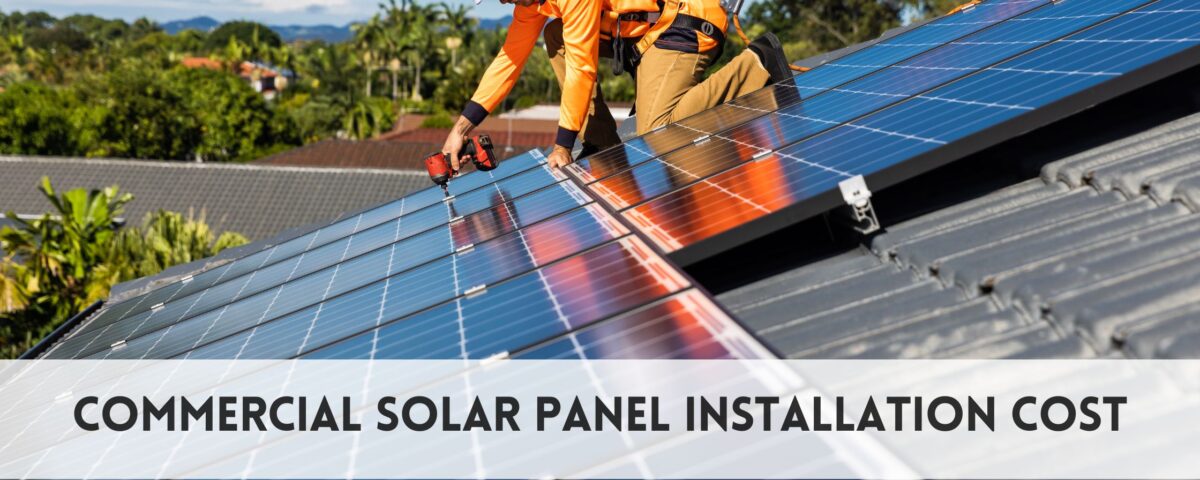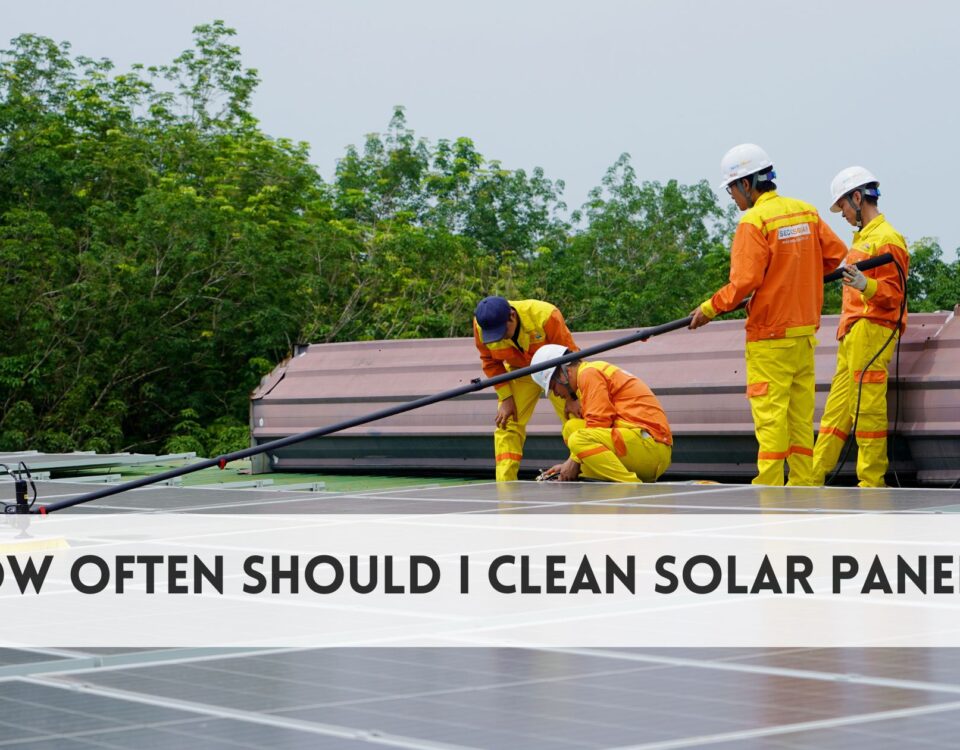
Do you need an electrician to install a ceiling fan?
April 25, 2025
Can you install solar panels on a metal roof?
May 7, 2025In today’s competitive market, businesses are continually seeking ways to cut operational costs and boost energy efficiency. One of the most effective solutions is installing commercial solar panels. Solar energy not only helps reduce electricity bills but also supports sustainability efforts by lowering carbon footprints. A common question businesses face is: What is the cost of commercial solar panel installation?
This comprehensive guide will explore the commercial solar panel installation cost in San Jose, USA, and provide valuable insights into the factors that influence pricing, such as system size, roof type, and location. Additionally, we’ll outline the installation process, cost breakdown, and the financial benefits of going solar.
By the end of this article, businesses will have a better understanding of the potential costs, savings, and long-term ROI of investing in commercial solar energy systems. Whether you’re considering solar for energy savings or sustainability, this guide will help you make an informed decision.
Commercial solar panel installation cost
While considering solar panel installation, businesses in San Jose can expect varying costs depending on their energy needs and building type. Below is an approximate cost breakdown for commercial solar installations based on system size and other contributing factors.
| Business Type | System Size (kW) | Installation Cost Range | Estimated Annual Savings | Payback Period |
| Small Business | 10-50 kW | $20,000 – $90,000 | $2,000 – $10,000 | 5 – 7 years |
| Medium Business | 50-200 kW | $90,000 – $400,000 | $10,000 – $40,000 | 4 – 6 years |
| Large Business | 200-1000 kW | $400,000 – $1,500,000 | $40,000 – $150,000 | 3 – 5 years |
Business Type and System Size
The system size required for commercial solar panels depends heavily on the size and energy needs of the business. Small businesses typically require solar systems ranging from 10 kW to 50 kW, which is sufficient to cover their lower electricity consumption. Medium businesses, with higher energy demands, generally need systems ranging from 50 kW to 200 kW, while large businesses may require systems from 200 kW to 1000 kW or more. A larger system allows businesses to generate more solar power, reducing dependency on grid electricity. Properly sizing your solar system ensures maximum energy efficiency and cost savings.
Installation Cost Range
The installation cost for commercial solar panels varies based on the system size, energy needs, and type of business. Small businesses with systems between 10 kW and 50 kW typically experience lower installation costs compared to larger systems. Medium-sized businesses with systems from 50 kW to 200 kW will see higher costs, reflective of the increased equipment, materials, and labor. Large businesses, which require 200 kW to 1000 kW systems, face the highest costs due to the complexity and scale of installation. It’s essential to factor in these costs when considering a solar investment for your business.
Estimated Annual Savings
The annual savings for businesses that install commercial solar panels can vary greatly depending on the system size and energy consumption. Small businesses can save anywhere from $2,000 to $10,000 annually, while medium businesses may see savings ranging from $10,000 to $40,000. For large businesses, savings can range from $40,000 to $150,000 per year. These savings come from reducing electricity bills, especially during peak hours when energy costs tend to rise. The greater the system size, the more electricity is generated, leading to larger reductions in electricity expenses for businesses.
Payback Period
The payback period refers to the amount of time it takes for businesses to recoup their investment in solar energy through energy savings. Small businesses typically have a longer payback period, ranging from 5 to 7 years, as they invest in smaller systems with lower savings. Medium businesses enjoy a quicker return on investment, with a payback period of 4 to 6 years. Large businesses, thanks to larger systems and higher annual savings, can expect a faster payback period of just 3 to 5 years. Understanding the payback period is crucial in assessing the financial feasibility of commercial solar investments.
How Are Commercial Solar Panels Installed?
Installing solar panels on a commercial building involves a well-structured process that requires professional expertise. Here’s a step-by-step guide to the commercial solar panel installation process:
Site Assessment
- Roof Orientation and Space: A solar expert will assess the roof’s orientation to ensure maximum sunlight exposure. The ideal roof is south-facing and free from obstructions like vents or chimneys.
- Shading Analysis: The expert will analyze the surrounding environment for potential shading issues from nearby trees, buildings, or other obstructions that could reduce panel efficiency.
- Roof Condition: The roof’s structural integrity must be evaluated to ensure it can support the weight of the solar panels. If repairs are needed, they will be addressed before installation begins.
- Energy Needs Assessment: A detailed analysis of your business’s energy consumption will be conducted to determine the appropriate system size that meets your energy requirements efficiently.
Design and Engineering
- Custom Solar Design: Based on the site assessment, a customized solar energy solution is designed. The system layout will include the optimal placement of panels and inverters.
- System Sizing: A professional solar engineer will calculate the optimal system size (in kW) based on energy usage and roof size, ensuring the business maximizes energy generation.
- Component Selection: The right type of panels, inverters, and battery storage (if applicable) are selected to fit your business’s energy needs and budget.
- Grid Connection: Engineers ensure the system is properly configured for seamless integration with the local utility grid, optimizing energy flow and minimizing disruption.
Permitting and Approvals
- Local Regulations Compliance: Solar installers will handle all necessary permits and ensure compliance with local building codes, zoning laws, and utility company requirements.
- Safety Standards: The installation will meet all national and local electrical safety standards, ensuring the system is safe for long-term use.
- Utility Coordination: Permits related to grid connection and interconnection with the utility provider will be secured, which might require utility approval based on the system size and location.
- Inspection Schedules: The permitting process will include scheduling required inspections by local authorities or third-party professionals to confirm adherence to building codes and safety protocols.
Installation
- Panel and Inverter Setup: Certified installers will position the solar panels and inverters as per the system design, ensuring the panels are securely mounted to the roof or ground structure.
- Wiring and Connections: Professional electricians will handle the wiring of the solar system, connecting the panels to the inverter and ensuring the electrical system is fully operational.
- System Integration: Installers integrate the solar system with your building’s existing electrical grid, enabling energy flow between the solar panels, inverters, and the business’s electrical system.
- Timeline: Medium-sized installations generally take between 1 to 2 weeks to complete, depending on the system complexity and the size of the business.
Inspection and Commissioning
- System Testing: After installation, the system undergoes testing to ensure everything is functioning as designed. This includes checking the electrical system for safety and verifying panel efficiency.
- Final Inspection: A licensed inspector reviews the installation to ensure it meets all safety regulations, building codes, and utility standards. Any required adjustments will be made before the system is activated.
- Grid Connection and Activation: Once approved, the system is connected to the utility grid, and your business will begin generating solar energy, which will be used to offset electricity costs.
- Monitoring Setup: A monitoring system is typically installed to track solar production and ensure ongoing efficiency. The system allows businesses to monitor performance in real time.
Cost Breakdown: What’s Included in the Commercial Solar Panel Installation Cost?
Understanding the components that make up the commercial solar panel installation cost is essential for businesses to make informed decisions. Here’s a breakdown of what the cost typically includes:
Solar Panels
The solar panels are the largest cost component of a commercial solar installation. They can vary in price based on factors like efficiency, type, and brand. Common types of solar panels include monocrystalline, polycrystalline, and thin-film. Monocrystalline panels are typically the most expensive but offer higher efficiency, meaning they generate more power per square foot.
On the other hand, polycrystalline panels are slightly less efficient but more affordable. Thin-film panels are the least efficient but also the most cost-effective in certain installations. Investing in high-quality solar panels can result in better long-term performance and energy savings, though they come with a higher upfront cost. Therefore, businesses must choose panels that align with their energy needs and budget.
Inverters
Inverters are critical components in any commercial solar system as they convert the direct current (DC) electricity generated by solar panels into alternating current (AC), which powers your business. There are two main types of inverters: string inverters and microinverters.
String inverters are more common and cost-effective, suitable for systems with minimal shading. Microinverters, on the other hand, are more expensive but offer higher efficiency and reliability, especially in installations with varying levels of shading or roof angles. The cost of inverters depends on the overall system size and quality. Larger systems with more panels require higher-capacity inverters. Therefore, businesses must evaluate their energy needs to determine the appropriate inverter type.
Mounting and Racking Systems
Mounting and racking systems are essential for securely attaching the solar panels to the roof or a ground-mounted structure. These systems ensure that the panels are positioned at the optimal angle for maximum sunlight exposure. The cost of these systems depends on factors like the roof type (flat or sloped), the complexity of the installation, and whether the installation is roof-mounted or ground-mounted.
Roof-mounted systems are generally more cost-effective but may require additional structural supports for flat roofs. Ground-mounted systems are typically more expensive due to the need for more materials and labor. Regardless of the mounting type, these systems are crucial for the stability and efficiency of the solar installation.
Labor Costs
Labor costs play a significant role in the overall commercial solar panel installation cost. Skilled professionals are required to install, wire, and configure the system to ensure it operates efficiently and safely. Labor costs typically account for about 15-20% of the total installation cost.
These costs can vary depending on the complexity of the project and the local labor market in San Jose. The installation process includes the mounting of panels, electrical connections, wiring, and configuring the system for optimal performance. Hiring qualified, certified installers ensures that the system is correctly integrated with your building’s electrical infrastructure, minimizing long-term maintenance costs and maximizing efficiency.
Permitting and Inspection Fees
Permitting and inspection fees are often required as part of the commercial solar installation process. These fees are associated with obtaining the necessary permits and inspections from local authorities to ensure the system meets all safety and building codes.
The permitting process can involve several stages, such as submitting plans, paying for permit applications, and scheduling inspections once the system is installed. The cost of these fees can vary depending on local regulations in San Jose, but they are an essential part of the process to ensure compliance. While some businesses may try to manage the paperwork themselves, it’s often more efficient to let a professional solar provider handle permits and inspections.
Optional Add-Ons
In addition to the basic components of a solar system, businesses may choose to invest in optional add-ons to enhance the performance and functionality of their commercial solar installation. Popular add-ons include battery storage systems and energy management systems.
Battery storage systems allow businesses to store excess solar energy generated during the day for use during nighttime or cloudy days, which can help mitigate reliance on grid power. Energy management systems allow businesses to monitor and optimize energy consumption. These add-ons can significantly increase the overall cost of the installation, but may provide greater energy independence and long-term savings. Businesses should weigh the benefits of these add-ons against their energy needs and budget.
Factors Affecting Commercial Solar Panel Installation Cost
- System Size: The larger the system, the more expensive it will be. This is because more panels, inverters, and other components are required. A larger system also means a greater energy output.
- Roof Type and Condition: Roof type (flat, pitched, or metal) and the condition of the roof can impact installation costs. A flat roof may require additional mounting equipment, while an old or damaged roof may need repairs before installation.
- Energy Usage: Businesses with higher energy consumption need larger solar systems, which increases the overall installation cost. It’s important to assess your building’s energy needs before choosing a system size.
- Location: Installation costs can vary based on geographical location due to differences in labor rates, permitting fees, and local incentives. San Jose’s proximity to solar energy providers means businesses can benefit from competitive pricing.
- Government Incentives: Available tax credits, rebates, and other incentives can significantly reduce the installation cost. The Solar Investment Tax Credit (ITC), for example, allows businesses to deduct 26% of their installation costs from federal taxes.
How to Estimate Your Commercial Solar Panel Installation Cost?
Estimating the commercial solar panel installation cost for your business requires evaluating several key factors:
Assess Your Energy Usage
- Review your energy bills: Examine your past year’s electricity bills to get an accurate understanding of your energy consumption. This will help you determine how much solar energy your business needs to generate.
- Identify peak energy times: Understanding when your business uses the most energy will help in optimizing your solar system. Solar energy can be used during peak hours, reducing reliance on the grid.
- Calculate your total usage: Add up your monthly energy consumption (in kilowatt-hours) to estimate the size of the system required to meet your business’s energy needs.
Consult with a Solar Provider
- Get professional advice: A reputable solar provider will perform a site assessment to evaluate your building’s roof space, shading, and orientation, which directly impact solar panel placement.
- Custom solar designs: Based on your energy needs and roof assessment, the solar provider will suggest a system design tailored to your business.
- Detailed cost estimates: After reviewing your energy usage and site conditions, the provider will offer a comprehensive quote, outlining costs for installation, equipment, and any additional services like monitoring systems.
Consider Financing Options
- Solar loans: Many financial institutions offer loans with favorable interest rates, making it easier to pay for your solar system in installments instead of a large upfront payment.
- Power Purchase Agreements (PPAs): Under a PPA, a third-party investor installs and owns the solar system, and you buy the electricity at a lower rate than utility companies. This option requires no upfront cost.
- Leasing: Solar leases allow businesses to install solar panels with no upfront costs, with monthly payments covering the installation and energy production. However, you may not be eligible for certain incentives.
Factor in Incentives
- Federal incentives: The Solar Investment Tax Credit (ITC) allows businesses to deduct a percentage of the total solar installation cost from their federal taxes, providing substantial savings.
- State and local incentives: Check for any state-specific rebates, tax credits, or incentives that can help reduce the overall cost of your commercial solar installation.
- Accelerated depreciation: Through the Modified Accelerated Cost Recovery System (MACRS), businesses can depreciate their solar system over a 5-year period, offering further savings on taxes.
Get Multiple Quotes
- Compare multiple providers: Reach out to at least three solar providers to obtain quotes. Each provider may offer different prices based on their system designs, labor costs, and equipment choices.
- Ensure transparency: Ensure that the quotes include all costs, such as labor, permits, inspection fees, and any additional equipment like battery storage or monitoring systems.
- Evaluate customer service: Look for providers with excellent customer service and a proven track record of timely installations. This helps ensure that the process runs smoothly without unexpected delays or issues.
Final Words
The commercial solar panel installation cost varies significantly depending on factors such as system size, roof type, location, and any additional equipment like energy storage. Businesses in San Jose can expect a range of costs for their solar installation, but the long-term benefits far outweigh the initial investment. By reducing electricity bills and taking advantage of tax incentives and rebates, businesses can see a substantial return on investment.
To accurately estimate the commercial solar panel installation cost, businesses should begin by assessing their energy needs and consulting with several trusted solar providers. Additionally, exploring financing options, such as solar loans or Power Purchase Agreements (PPAs), can further reduce upfront costs. As solar energy becomes more affordable, now is the ideal time for businesses to transition to clean, sustainable energy and enjoy the financial benefits of a cost-efficient future.


